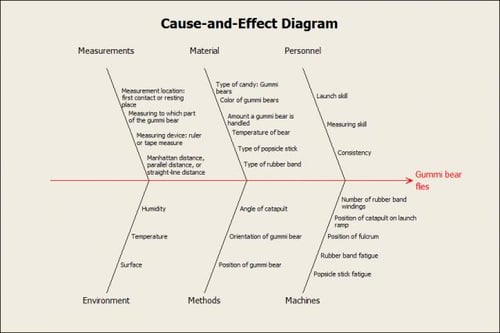In recent posts, we’ve reviewed a number of Measurement Systems Analysis (MSA) studies: Type I Gage Studies, Linearity and Bias Studies, and Gage R&R Studies. Before that, we took a look at a cause and effect diagram, also called a fishbone diagram. And we did all this because we were getting ready to practice a designed experiment.
Remember the fishbone diagram?

On the fishbone diagram, I came up with 24 variables that might affect how far the gummi bears go. I’d like to study as many of these factors as possible, but first need to decide which ones I can both manipulate and measure. Here are some of my ideas about these:
| Variable | How to measure | How to manipulate |
|---|---|---|
| Angle of catapult to the ground | Use a protractor to measure the angle | Move the catapult to high and low angles by placing something underneath the back of the launch ramp. |
| Position of gummi bear | Distance from the top of the popsicle stick | Move the gummi bear farther and closer to the top of the catapult. |
| Number of rubber band windings | Number of times I loop the rubber bands | Determine the minimum number of windings that will hold the popsicle sticks. See how many more times I can wind without breaking the rubber band. |
| Position of catapult on the launch ramp | Distance from the top of the launch ramp | Move the catapult from the top of the launch ramp to the bottom. |
| Position of fulcrum | Distance from the open end of the catapult | Move the fulcrum closer and farther from the rubber bands at one end of the catapult. |
| Orientation of bear | Categories based on the surface touching the catapult. | Place the gummi bear on its back, front, feet, side or head. |
| Color of bear | Categories based on dye color | Launch gummi bears that are different colors. |
| Temperature of bear | Thermometer | Heat and cool bears using microwave and freezer. |
| Popsicle stick fatigue | Number of times the stick is flexed to launch a gummi bear | Use the same stick to do many launches to cause fatigue. |
| Rubber band fatigue | Number of times the rubber band is used to launch a gummi bear | Use the same rubber band to do many launches to cause fatigue. |
Of course, just because we can measure and manipulate a variable doesn’t mean that we want to study that variable with design of experiments. For example, even if freezing the bears caused them to be more accurate, do I really want to keep gummi bears in the freezer to do this experiment with when I’m trying to hit a target later? My answer is “no”, although I hope it won’t discourage the brave among you. If you’re not going to be willing to manipulate the variable in practice, because it’s too time-consuming or too expensive, it becomes less important to study what happens when you change it.
Another factor to consider is existing knowledge. The exercise I’m adapting identifies color as a variable that doesn’t have an effect. If we already know a variable doesn’t matter, it doesn’t make sense to study it with design of experiments.
But the more variables we study, the more we know. I’m going to plan to manipulate these variables:
• Position of gummi bear
• Number of rubber band windings
• Position of catapult on the launch ramp
• Position of fulcrum
I expect that will give me some fun things to observe, including interactions between the variables. The effect of moving the gummi bear down the popsicle stick might well depend on where the fulcrum is! Next time, we’ll talk a little bit about what to do with the variables that won’t be the focus of the experiment.
Have time for a little more? Check out the breadth of DOE applications that Patrick Runkel describes in DOE—It’s Not Just for Widgets Anymore.



